A guide to understanding direct action and how it can achieve political goals
Direct action is a form of action where people use their power to directly achieve political goals. Unlike indirect methods like voting or lobbying politicians, people taking direct action aim to meet their goals through their own activity, rather than the actions of others.
Direct action is often disruptive – it can involve people using their bodies to cause or prevent something happening, or acting collectively to exert pressure on a target. Tactics such as blockades, strikes, pickets, occupations, or property damage are examples of direct action. However, other examples don’t involve protest. For example, mutual aid, where people organise themselves to directly meet needs that are not being met by the state or those with power.
There are many different activities that people call direct action, and we haven’t used a strict definition in this guide. What is ‘direct’ and whether it’s effective depends a lot on the context – the campaign that an action is part of, or the political situation it happens in.
In this guide we offer five examples of actions from Britain that were successful in their context, and analyse why, to help you think through:
These questions are useful to understand how direct action could work in your own context. The Campaign Strategy and Affinity Groups guides on our website are more focused on practical tips for taking direct action.
In analysing these examples, we also received input from people who were involved, to help provide a fuller picture of the action and its context. Thank you to everyone who inputted into this guide!
There are a lot of misconceptions about direct action – what it looks like, what it’s used for, and who can do it. These myths can be off-putting, so they are very convenient to people who oppose our campaign goals!
People involved in direct action can also contribute to these myths without meaning to. For example, it’s common for direct action groups to celebrate risk-taking and personal sacrifice for its own sake, rather than the actual impacts of the action. In this instance, the intention is probably to boost the morale of the group and take care of each other. The downside can be that this feeds the idea that people can only take part in direct action if they are in a position to take deliberate risks with their safety or legal standing.
We’ve addressed some common myths below.
While some forms of direct action involve breaking the law, many tactics don’t involve doing anything illegal. Very few of the examples in this guide led to a criminal conviction (though of course that is no guarantee that people might not be arrested for taking similar actions in future). There are also lots of different roles people can take in actions, some of which come with a much lower risk of arrest.
Some kinds of direct action might involve climbing things, attaching yourself to something or putting your body in the way of equipment. But using your body could also mean simply being part of a crowd in a blockade, or slowing down a vehicle by walking together in front of it. Other forms of direct action aren’t physical at all – like withholding your rent or labour in a strike.
Actions that require special skills or equipment are in the minority, and skills specific to a particular tactic are often easy to learn from other people. The examples we’ve given here show how people can participate in direct action with various levels of preparation, skills and experience.
Police, security guards and the companies or individuals who are targeted by direct action often accuse people taking part of being violent. Some of the examples in this guide involve property damage or being verbally confrontational, but none of them involve harm to people or animals. Direct action also raises the question of what we think of as violence. Very often direct action is used against structural violence that harms many people but is made to seem a normal part of life, such as poverty, environmental destruction, or border regimes.
Lots of direct action happens in secret! And even in public people can take effective action without arrest, through careful planning or strength in numbers. The examples here show hundreds of people involved in effective actions who were not arrested.
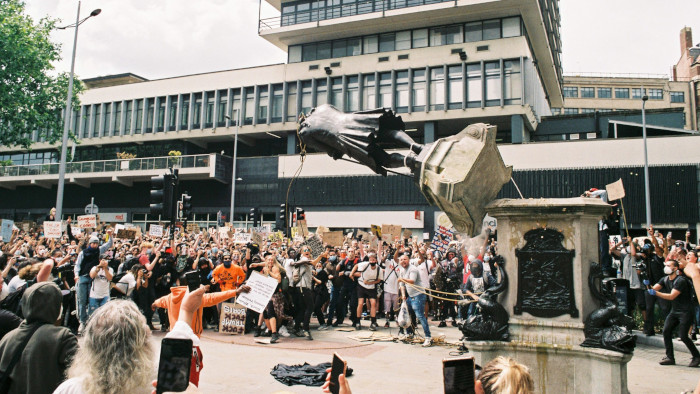
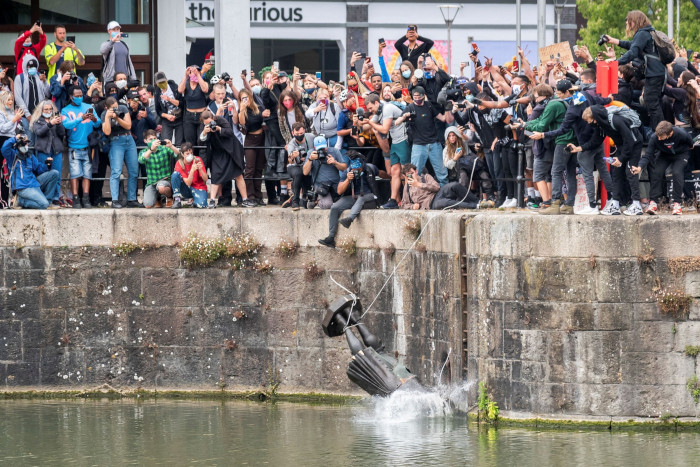
On 7th June 2020, the statue in Bristol of 17th century slave trader Edward Colston was toppled. This happened during mass protests against racial injustice following the police murder of George Floyd in the US. The statue was surrounded by a large crowd of protestors, pulled down with ropes, defaced and thrown into the harbour.
The route of a planned protest march passed by the Colston statue. Two protestors brought ropes with them. The crowd arrived at the statue, which had been covered with a cloth in anticipation of the protest. People ripped off the cloth and threw eggs at the statue, chanting ‘pull it down!’ The ropes were passed up to three people who had climbed onto the plinth. They fastened the ropes around the head of the statue and jumped down. People in the crowd cleared a space and helped pull on the ropes until the statue toppled. They jumped on it, defaced it with paint, rolled it down to Bristol Harbour and pushed it into the water.
The Colston statue had been opposed within Bristol for many years, including petitions to the council for its removal and several direct interventions by Bristol residents. In 2017 an unofficial plaque had been added to the plinth acknowledging Colston’s participation in the slave trade. At the time of the 2020 protest, a petition for the removal of the statue had gathered over 10,000 signatures.
The protests following George Floyd’s murder were large-scale, global, and lasted for many months. Numerous other statues related to slavery and racial exploitation were defaced or destroyed in the UK and elsewhere. The toppling of Colston was referenced two days later at George Floyd’s funeral, where Reverend Al Sharpton said: “All over the world I’ve seen grandchildren of slave masters tearing down slave masters statues – over in England they put it in the river.”

This example focuses on an immigration raid. This is a tactic used by the UK Home Office in which officers target homes or workplaces to detain people suspected of ‘immigration offences’. These raids are often carried out with the aim of deporting asylum seekers. Many of them happen in the early morning and are known as ‘dawn raids’.
In May 2021, an immigration raid on Kenmure Street in Glasgow was stopped by people surrounding the immigration van and preventing it from moving. This action involved a small number of people initially blocking the van including one person underneath it. Later, hundreds more people arrived having heard about the raid through neighbours, local networks and social media. The police brought in horses and riot shields, but were not able to disperse the crowd. People surrounded the van chanting “these are our neighbours, let them go!” They remained there for 8 hours until the two detained people were released. The reason given by police for their release was that the van could not move while maintaining public safety.
Raising the alarm: Someone on their way to work saw the immigration van and sent out a photo to local anti-raids networks. The first few people arrived on the scene having seen the alert or seen the raid themselves.
Physical obstruction: One person got underneath the van and others sat behind and in front it. People filmed the officers and legally observed their actions to challenge the raid. This bought time until more people arrived and formed a crowd of hundreds filling the street.
Welfare: The person under the van lay there for the whole action while other people brought blankets, hot water bottles, food and drink to keep the person comfortable. A free food and water station was started in a bus stop and people filled it with supplies. Local residents and businesses let people use their toilets to allow people to remain in the streets for as long as necessary. Other people provided legal and emotional support. A lawyer arrived and forced the police to allow a paramedic to carry out a wellbeing check of the two people detained inside the van.
Although the anti-raid action on Kenmure Street was a spontaneous mobilisation, it built on years of prior organising in Glasgow against the hostile environment. Some key participants in the action were members of Glasgow’s No Evictions Network, set up in 2018 to stop evictions of people living in asylum accommodation. They had been organising anti-raids training and outreach in the city. Another recent raid had also led to protests and open meetings in the weeks before the Kenmure Street raid.
All of this prior organising meant that local people were able to recognise a raid and intervene. It also helped the call-out spread quickly through trusted networks, and meant that the community had the skills to act confidently to prevent the raid. The action did not rely on a centralised organisation to respond and direct people, but quickly mobilised hundreds of people in the community around a single clear aim.
Other community factors also had an effect – the attempted raid happened on the day of Eid, in a well-connected neighbourhood where the two men detained in the raid were active in the community. The tenements on the Kenmure Street are four storeys high and populated with renters, migrants and working class people. Local mutual aid networks had been set up in response to the covid pandemic. Pollokshields is also an area where people have common experiences of racialised policing and profiling, and distrust of police is high.
The influence of other collective direct action by people in Glasgow can also be traced, with examples such as the Glasgow Girls 2012 campaign against dawn raids, collective actions against exploitative landlords by Living Rent tenants union, and even the anti-poll tax unions in 1989-90 in Scotland which physically prevented evictions.

In November 2020, around 200 students at Manchester University went on rent strike over their treatment during the coronavirus pandemic. They called for rent reductions and mental health support for those living in university accommodation, after their courses were moved online and campus facilities shut down. Hundreds of students participated in protests on the Fallowfield campus, including tearing down fences that were put up overnight surrounding their halls, reportedly to stop non-residents entering. A group of students occupied Owens Park Tower, a block on the campus, for two weeks. The action resulted in a 30% rent reduction amounting to 12 million pounds.
Co-ordination and publicity: The rent strike was initially organised by a group of 5 students who used social media to communicate their demands and build participation in the strike. They collected and publicised stories from students about their experiences of exploitation by the university. Around 200 students signed up to an online form declaring their intention not to pay their rent. A working group posted regular updates and outreach on social media. One person maintained contact with a lawyer giving legal advice throughout the rent strike.
Property damage: The fences were put up around the students’ halls during the course of the rent strike, and were torn down within 24 hours in spontaneous protests by students. This was covered by national media, generating attention that was critical in the success of the strike.
Occupation: After the university refused to meet with them, 12 students decided to escalate pressure by occupying the Owens Park Tower. They used plans of the building and explored it beforehand, ready to enter and occupy the whole building. They blocked the front door with sofas and hung banners from the tower windows declaring the occupation. It continued for two weeks, with people bringing food and supplies. A group of students supported the occupation from outside by acting as a press team, organising national media interviews to increase pressure on the university. Members of the UCU, the university staff union, came and spoke outside the occupation, declaring their support.
The strike used remote organising very effectively in the context of the covid pandemic to overcome isolation and unite the students around a common experience of exploitation. It was possible to organise a mass rent strike quickly due to the students all being in university halls and therefore applying financial pressure on the same target.
Media coverage was key in making the strike effective, applying further leverage against the uni through the threat of reputational damage. Escalating actions, including disruptive protests and the occupation, built the pressure of the strike and maintained media attention.
The pandemic restrictions meant that work at the university had mostly been suspended, undermining the disruptive impact of an occupation in offices or work buildings. This meant that media attention became the key form of pressure generated by the occupation. The Owens Park Tower, a disused residential building, had a strong visual impact on the campus and in media images. Photos of the occupied building were spread on social media and in national news. As well as communicating their strike demands, the students used media opportunities strategically to put across their political analysis, calling for an end to the management of universities for profit.
Wider effects
The Manchester rent strike inspired strikes at a further 56 UK universities. Key organisers in these actions maintained communication and supported one another by sharing skills and advice.
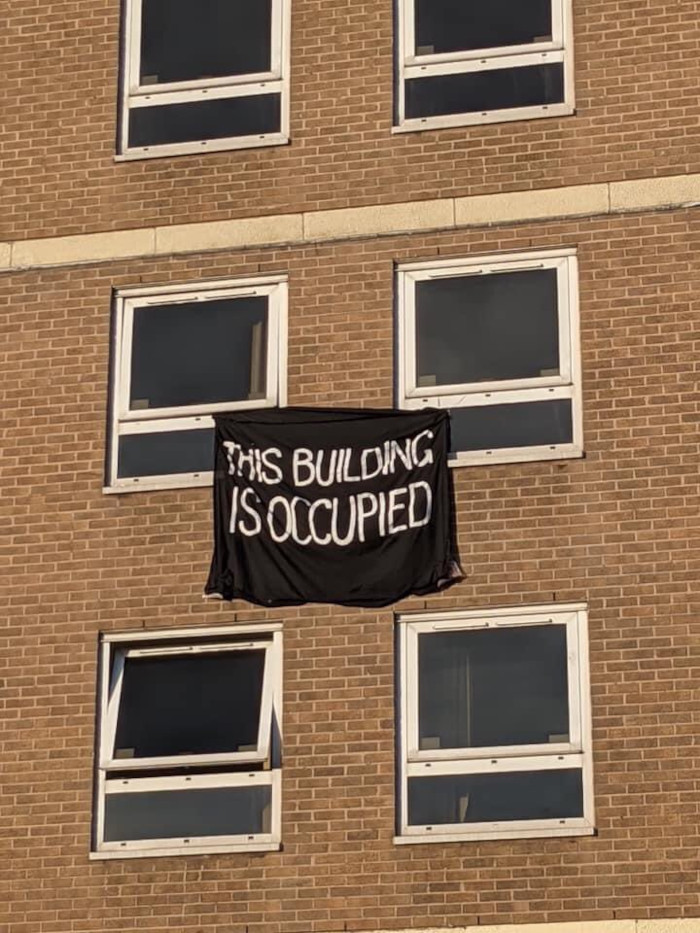
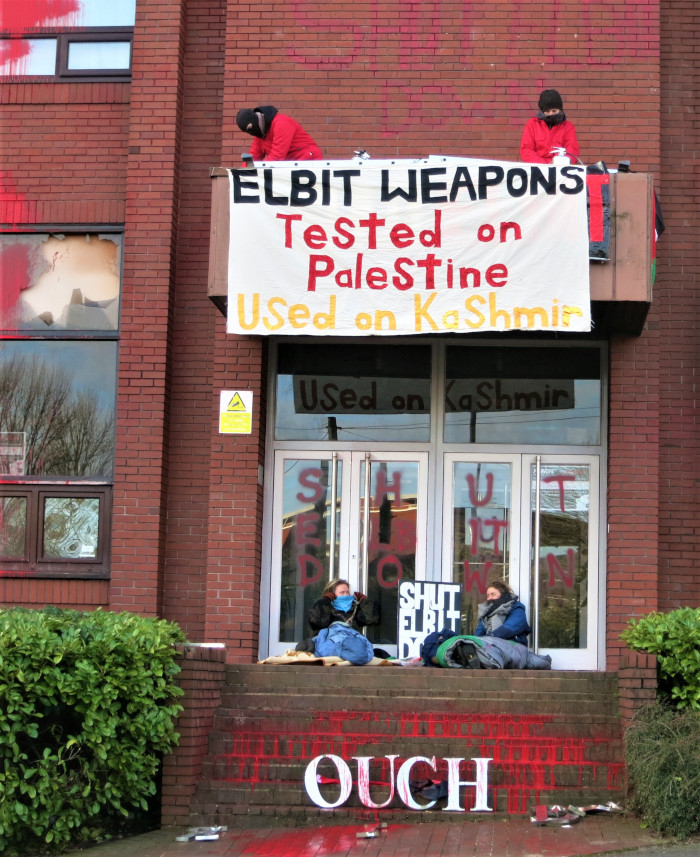
From August 2020 onwards, activists from Palestine Action targeted the Elbit Ferranti arms factory in Oldham to stop the production of Israeli weapons used against Palestinians. Over a period of 15 months, people occupied, blockaded, smashed and disrupted the site, forcing it to shut down entirely in January 2022.
There were around 10 different actions targeting the site over 15 months, using a variety of tactics, and escalating in frequency and amount of damage. In the initial occupation in August 2020, people sprayed the premises in red paint symbolising the Palestinian bloodshed made possible by Elbit weapons. Later actions involved blockading the site entrance with vehicles or lock-ons. Lock-ons involve people using objects such as bike locks, handcuffs or arm tubes to secure themselves in place and prevent police from removing them easily. Protestors also scaled and occupied the roof, breaking windows and causing damage. In April 2021, activists gained entry to the factory itself and smashed the roof, windows and air vents, and covered equipment and computers in red paint. This caused £100,000 worth of damage and closed the site for a number of weeks. Another action in July 2020 caused £500,000 worth of damage.
Actions often involved a small number of people (3-4) entering the site itself and causing damage in a carefully planned way. There were often many more people involved in blockading the entrance or protesting outside, either simultaneously or as part of a separate action. There was a long-standing community campaign based in Oldham against the factory, organising vigils and large weekly protests at the site. This meant Palestine Action occupations were supported by crowds of local people, as well as protests outside the police station when people were arrested.
Other roles involved in the actions were drivers, photographers and live-streamers, people putting ladders up to the roof prior to an occupation, passing up water to those on the roof, offering their homes to stay in nearby, or providing court support.
Palestine Action adapted their tactics with each action. They often used two or three things happening at the same time to divert attention, for example blockading the gates of the site while a few people entered and climbed on the roof. Using the roof meant it was harder for police to remove the protestors, buying time to mobilise more people from the community without having to publicise actions beforehand.
People gathered information about the factory site before actions, such as where the entrances were, ways onto the roof, who was working at a given time, what equipment would be needed, and anything that had changed since the previous action. The planned timings of actions were sometimes changed at the last minute as a security measure. People often wore masks to conceal their identities.
One thing that made this campaign successful was that it applied multiple forms of pressure against Elbit. Actions caused millions of pounds of economic damage, through both damages and the closure of the factory.
Campaigners also used the fact that any security breach meant the site had to be closed down, so only a small number of people entering the building would to shut the site, compared to a big group blockading the entrance. For example, smashing a window or throwing paint on the building could shut the entire site down. Acting as small groups of 3 or 4 meant that it was easier to plan a secret action without getting stopped. The small number of people involved each time also meant each action required less capacity, which allowed for sustained action over a long period, creating overwhelming pressure on the Oldham site.
With each action, Elbit increased their security, causing them further cost. In addition, a security breach of the site would have to be reported to the Ministry of Defence, disturbing Elbit’s contracts with them and increasing reputational damage.
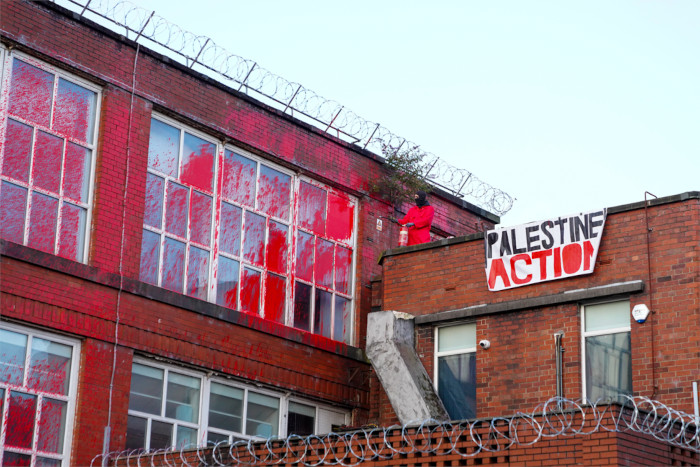
Media coverage also generated reputational pressure against Elbit, with images of the factory covered in blood red paint shown in the national press. Palestine Action put out photos and footage of actions on social media, as well as videos of participants explaining why they were taking action in solidarity with Palestinians. They also shared stories of community support, and people being released after arrest.
Another important piece of context was the way the community campaign and direct actions worked together. Weekly protests built awareness of what was happening at the site, and in turn high profile direct actions led to community mobilisation as local people became involved with Palestine Action’s occupations. Significant involvement also came from Oldham’s Kashmiri community, due to the fact that Elbit weapons are also used against people in Kashmir.
This action campaign kept a single focus, concentrating pressure on one factory until it closed. Other people in Palestine Action’s wider network were targeting 3 other British Elbit factories with similar sustained attacks. In addition to attacks on these sites themselves, direct action was carried out against secondary targets involved with the factories, such as site landlords, suppliers and transportation companies.
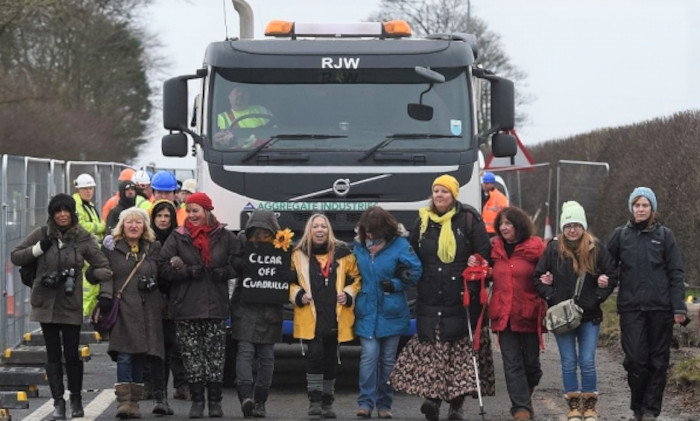
As part of the community campaign against fracking at Preston New Road in Lancashire, people carried out ‘pop-up’ actions between 2016 and 2017 at a variety of subcontractors involved with the fracking site. The biggest of these was AE Yates, the construction company building the site, but targets also included a number of smaller local firms involved in construction and transportation.
The pop-up actions aimed to pressure these companies to withdraw from the fracking operation. People used a variety of tactics including blocking entrance gates, and stopping or ‘slow-walking’ lorries in and out of the sites. Some of the contractors dropped out, and those that continued suffered major financial impacts. The pop-ups significantly delayed the overall fracking operation. The widespread anti-fracking campaign in Lancashire contributed to the eventual defeat of fracking through a national ban in 2019.
Calling an action: The pop-ups were designed to be unpredictable, and were often called last-minute. Sometimes people sent out text alerts to local groups calling for an early morning action the next day at a particular site, where a crowd of people would block the gates or slow-walk vehicles in and out. Some actions were initiated by a small number of people using lock-on equipment, who would then send a public call-out for people to come and join them once they had already established a blockade.
Varied tactics: People also stood outside contractors’ sites and kept records of vehicles entering and leaving to track their involvement with the fracking site. Actions at AE Yates, the biggest fracking contractor, ranged from one or two people stood at the gates tracking delivery vehicles, to protests of 100 people blocking the site. There was a regular ‘family day’ where local families came with banners, drums and food and blocked the gates. Actions were also livestreamed on social media.
Slow-walking: A vehicle could be delayed by a group of people walking slowly in front of it. AE Yates’ site, for example, was situated at the back of an industrial estate with a long entry stretch off the main road. People were legally able to slow-walk lorries across this area, meaning they could delay a delivery entering or leaving the site by up to an hour.
Remote pressure: As well as direct action at the contractors’ sites, local people made phone calls and sent emails to contractors pressuring them to withdraw from the fracking operation.
The pop-ups were designed to maximise autonomy. They tended not to rely on technical or legally high-risk direct action tactics, but instead used methods like slow-walking that varied numbers of people could participate in easily and without prior planning. The spontaneous and unpredictable nature of the pop-ups meant that companies were under constant threat of disruption.
Blockades at contractors’ sites would delay all their vehicles, not just those headed for the fracking site. Some of the deliveries from AE Yates were destined for loading onto ships; if one of these could be delayed for an hour, for example, it might miss its boat. This applied increasing financial pressure on the company. For smaller contractors, the cost of a day’s blockade could be overwhelming. A small quarry firm dropped out of the fracking contract after just one action, where around 20 people blocked trucks from leaving the quarry.
It became clear early on that AE Yates would not withdraw from the fracking contract, so protestors focused on a delaying tactic to slow down the construction of the fracking site. The aim was to build enough financial pressure through delays that it would be too costly for Cuadrilla – the fracking company itself – to pursue fracking in Lancashire. Construction of the fracking site was intended to be a 4-month project for AE Yates – instead it took 18 months, causing them major financial costs.
There were hundreds of people who were part of local groups or attending public meetings in nearby towns affected by fracking at Preston New Road. The pop-ups meant that these people could participate in direct action at a secondary target near them, rather than having to travel to the Preston New Road fracking site, which was further away and often more heavily policed. For example, AE Yates was consistently targeted by local group Bolton Against Fracking. The pop-ups brought a larger number of local people into the direct action campaign, and spread the attack across multiple fronts. Many of them went on to became involved in blockading the fracking site itself.
Growing participation in the campaign resulted in a large-scale, strong and high-profile movement against fracking. The visibility and strength of this movement was a factor in the increasing political unpopularity of fracking, and it was eventually defeated at a national policy level.
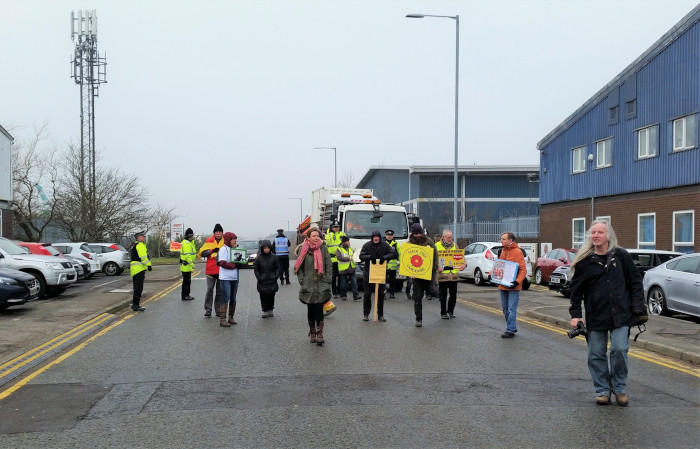
The fracking site at Preston New Road was heavily securitised due to the protest campaign. As well as company security guards, there were police under central command operating there daily. They were often violent to protestors and arrests were common. Subcontractors’ sites did not have the same security, and local police tended to respond more slowly and less violently to protests. This created an opportunity for more people to get involved at a lower level of risk. Very few arrests were made at the pop-ups, and convictions were even more rare.
In each of these examples we’ve explored the factors that played a role in the success of the action, including how it was carried out, and the context it happened in. We’ve drawn out some key points below.
It’s rare that we can point to the impact of a stand-alone action. Looking closer at each of these examples, it’s clear they are built on things that came before, and which helped them to be effective. Often direct action is one tactic in a sustained campaign, and works alongside other tactics that bring a wider range of people in. Campaigns involve being strategic – analysing the issue, and thinking how to take action that will move things towards your goals.
Whether it’s a spontaneous mobilisation or a tactic in a long-term campaign, direct action is most effective when there is a clear aim. Knowing your aim helps you plan actions well, and guides decisions in the moment about how to act. For example, Palestine Action aimed with each action to close the Elbit factory for a period of time, and they developed increasingly efficient methods of doing this.
A key factor in the success of all these actions is that they were strategic in applying pressure on their targets – whether it was financial, reputational, or physical. Thinking through what collective power you have, and what forms of pressure your target is most sensitive to, helps an action make the biggest impact. When the rent strikers at Manchester Uni realised financial pressure alone was unlikely to be enough, they focused on reputational pressure on the university. They chose a visually striking building to occupy, ran a strong media campaign and obtained national news coverage – forcing the university to concede.
A related principle is identifying best ‘points of leverage’ - these are the places where you have the power to make the most impact towards your goals with the smallest effort. For example, instead of throwing all their energy at the fracking company itself, anti-fracking campaigners focused on secondary targets. These local contractors were less committed to the project as a whole, and could afford less financial risk, so a smaller amount of pressure could cause a bigger impact. Those contractors dropping out created a greater overall financial pressure on the fracking company.
In both the Colston statue toppling and the Kenmure Street anti-raid action, large numbers of people were mobilised from the immediate community without prior planning. Many of them did not have ‘activist’ experience. One question to ask yourselves is how much political consciousness and organisation that already exists in a community. This includes the institutions or informal networks that exist, as well as the attitudes people have developed around an issue. The history of physically obstructive direct action in Glasgow, and the existence of organisations and networks resisting the hostile environment, was an important factor in the community response to the Kenmure Street raid.
These factors can be hard to analyse, and need thinking about long term! It’s useful to think through how an action might be received by the local community in a particular context, and what ways you can engage with people to build community support for your campaign.
Each of these actions involved a wide range of different roles. High visibility and high risk roles are easily recognised and often celebrated, but actions can’t happen without many other tasks happening behind the scenes. The examples here included drivers, photographers, media organisers, community outreach contacts, legal support, people providing food and housing for actions, etc. It’s important for the people involved to think about how different actions fit with their own boundaries around risk and legal consequences.
As well as logistical roles, there are people involved in care and wellbeing to help make direct action a good experience and a sustainable practice. It can be really useful for some people to take on specific roles to support people’s wellbeing during and after an action – like making sure people are comfortable during a lock-on, or doing arrestee support at the police station. Some key things not addressed in this guide are around looking after each other during an action – for ideas on this see our guides Affinity Groups and Campaign Strategy.
